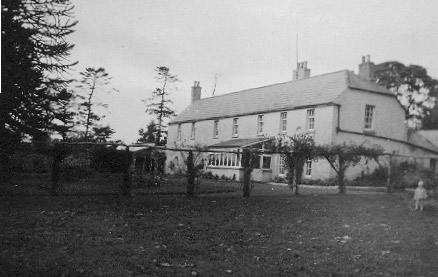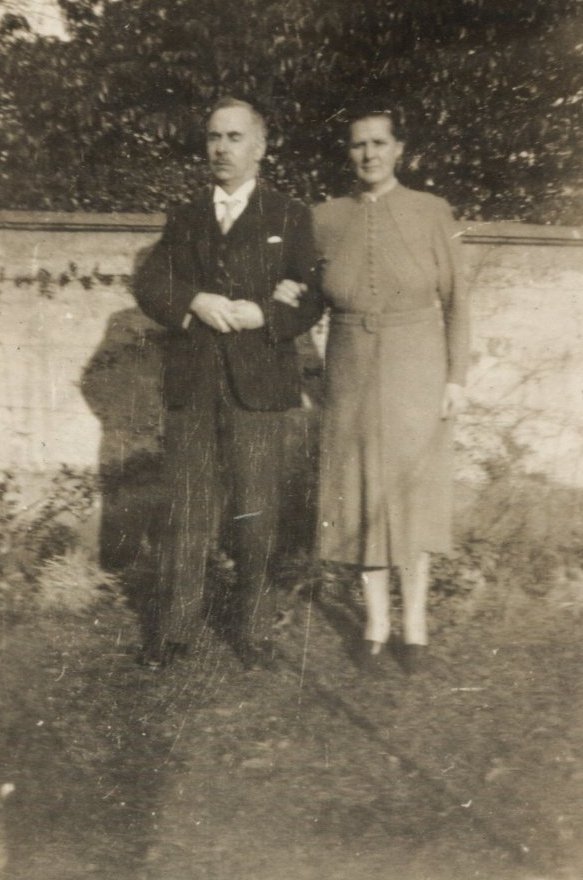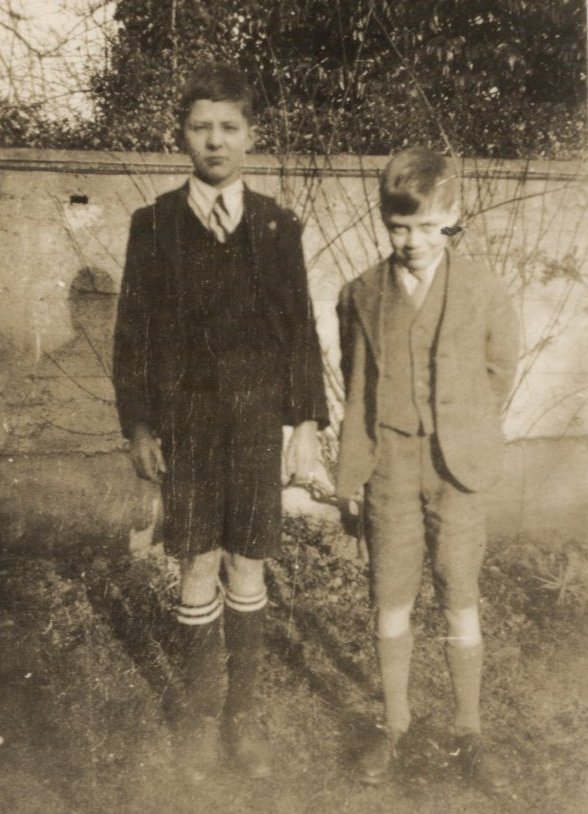Century of Endeavour
The Family in the 1930s
(c) Roy Johnston 2003
(comments to rjtechne@iol.ie)My sister has seen this and has contributed some additions.
We have during the 30s the move in the autumn of 1931 from Dundalk to Drogheda, and then in 1934 to Dublin, to 2 successive addresses, for my education. This mobility was now feasible, thanks to the family problems being more or less resolved, with both grannies suitably accommodated, and Tommy and Alec, the late Sam's orphaned sons, with Ann in Blackrock, Geddes the third one having gone to Argentina.
The move to Priorland near Dundalk in 1928 had whetted JJ's appetite for hands-on farming, but the commuting travel-time load must have been a strain, and my mother I gather had problems coming to terms with relative rural isolation. My sister went to Dundalk Grammar School as a day-pupil; it was within cycling distance. When I arrived in 1929 it must have increased the stress.
The Dundalk period gave JJ access to the neighbouring Barrow farm at Milestown, near Castlebellingham, and he analysed the economics of this successful labour-employing commercial farm in depth, using the results in published papers.
The decision to move nearer to Dublin, while still keeping in touch with hands-on farming, I suspect was made in 1931, before the Fianna Fail electoral victory in 1932. A move like that made in 1932 would have involved JJ ignoring strong warning signals. My memories of Priorland are very hazy, as is my memory of the Christmas spent with the MacManuses in Longford, so I am inclined to date this episode to 1931, and relate it to the move to Newtown Platin, and perhaps to the need to give my mother a bit of a rest, after the stress of the move.
The farm near Drogheda was called Newtown Platin; there was a long low farmhouse, and a walled garden. There were monkey-puzzles in the front garden, conveniently placed for JJ to swing his hammock. (The lore was that when he moved house the existence of trees close enough to swing a hammock was a necessary condition!).

Newtown Platin, circa 1933.
There was a farm-yard and stables behind, and a farm worker whose name was Brown lived there, with a young family; their names were Georgie and Vonnie, and I played with them. There was also an elder brother who had a job on the buses. JJ ran the farm by telling Brown what to do, and keeping the books. This was the beginning of the economic war, and of course the upshot of JJ's farming was disastrous, though it gave him practical insights for his writings.
Platin was to the west of Drogheda, and it was easier to get to Dublin in the Ford Model A by the back road, which led south-west to the Derry road, entering Dublin by Ashbourne and Finglas. It was about an hour's drive. We could time his return, and I remember being brought out for a walk to meet him, and we would get a lift back.
My sister entered College in 1933, after finishing in Dundalk Grammar School as a boarder, and did medicine. She began doing Natural Science, at JJ's suggestion, and switched to the medical school subsequently. We had a gramophone, and recollect at this time a Maurice Chevalier record, 'up on top of the rainbow, sweeping the clouds away'. My sister had been in France in the 20s during JJ's Rockefeller episode, when they stayed at the Albert Kahn Foundation.
I remember being lifted up one day, to look over the wall, to see the Blueshirts marching. Also I remember being driven into Drogheda in JJ's Model A Ford (whose registration I remember was IY2243, and I have never since then remembered any registration of any car!) and JJ giving a lift into town to old Brown the grandfather of the family who lived in the stables. There was a further occasion when children living in cottages nearby threw mud at JJ's windscreen.
I remember JJ pointing out the electric transmission lines which crossed the field nearby, and relating them to the 'Shannon Scheme', of which he was aware and regarded as a good thing.
It is appropriate in the Platin context to mention the elder brothers James and John, who visited JJ in Ireland in 1933 or thereabouts; I have a dim recollection of them; James was very globular; it is in the family lore that we visited Newgrange, which was quite near to Newtown Platin, and James got stuck in the passage.
James retired in or about 1932; the visit to Drogheda must have been associated with this event. He went to live in Jersey, and published a book Can the Hindus Rule India?, PS King, London 1935 (incidentally the same publisher who had taken Nemesis of Economic Nationalism for JJ). This was a polemic against the then Government's proposal to introduce a federal system to India in which the States under their feudal rulers would have had status which he compared to the pre-Reform 'rotten boroughs'.
He took a dim view of the Hindu religion, and predicted that any attempt to impose Western democratic structures on India would be subverted by the workings of the caste system. Gandhi he regarded as humbug, who on occasion connived at the massacre of Muslims, a view which would not be fashionable today. He did however accurately identify the factors which subsequently led to the partitioning of India and the emergence of Pakistan.
Throughout the book however there is in evidence an aspiration to achieve the secular democratic objectives of the Enlightenment, and a belief that these were realisable within the British imperial system. In this context he supported Irish Home Rule, as did the rest of the family. He believed that the Irish should be participating on an equal basis in the 'civilising mission' of the Empire.
James regarded the Muslims as being more 'us', with their rejection of caste, and their monotheism. However he never resorted to suggesting any analogy with the Ulster 'Rome Rule' perceived threat. He does however make frequent references to Irish analogies in political terms, with lessons for India in the de Valera experience, and an understanding of the parallels between Congress and Fianna Fail, some of which were quite perceptive and indeed predictive.
This visit by James and John to Platin I suspect involved a family conference on Geddes, whose role in Argentina seemed to have been open to question. There is extensive and rather acrimonious inter-family correspondence about Geddes around this time, on record among JJ's papers. It seems one option being promoted by JJ was to bring him back and get him into a management role in some agricultural enterprise, but he did not buy this, preferring his somewhat adventurous gaucho role. The correspondence peaked in 1932, and then tailed off, with another peak around 1935-36, when he was set up with the Traill 'Estancia la Ventura', so something must have got sorted out; we basically lose sight of Geddes until he came back in 1941 on his way to join the RAF. He had learned to fly in 1939, and got a few hours flying time to his credit, but he was not accepted as an operational pilot; according to my sister he had defective eyesight.
To return to my own family stream: I paid a nostalgia visit to Newtown Platin in 1996; it is now overshadowed by the Platin cement works. The house is a ruin; there are traces of the walled garden, but the monkey puzzles are still there.
After the move from Newtown Platin to Dublin, which was motivated in part by a desire to get out of farming due to the economic war, and in part by concern for my education, I went to school, first at a kindergarten in Morehampton Road, Park House School; this is still in existence at the same location, as a rather superior girls' school. JJ used to drive me to school, in the same Ford Model A, from Waltham Terrace, where we rented no 8, a substantial Victorian semi-detached house.
The local 'national' primary school in walking distance was in Merrion Avenue, under the usual church management (which relationship earns the adjective its quotes). This was apparently regarded as not appropriate to our social position, so I never experienced the rough end of the national education system.
I therefore started in Avoca School, which was a private fee-paying Protestant school, with primary and secondary levels, initially located in Carysfort Avenue, in a premises which was subsequently taken over by the Bradmola textile factory, in the 30s industrialisation drive. The school was initially in easy walking distance from Waltham Terrace, and I seem to remember having fun with a friend, one Gordon Martin, who lived in the Green Road, on the way home, and getting into trouble at home for arriving late.
When the school moved to its new location, in Newtown Park Avenue (the site now occupied by Newpark Comprehensive; the old buildings are still there), the walk would have been somewhat prohibitive for a six-year-old (we are now in 1935-6). So the family moved from Waltham Terrace to Newtown Park Avenue, to a house called Charleville, which was a substantial mansion that had been divided up. The main part of the building was occupied by Seamus Clandillon, who at the time was the head of Radio Eireann; Charleville was a wing. This was five minutes walk from the school.

My mother and father in the garden at Charleville, circa 1938.
I have mostly fond memories of Avoca School; the head was Cyril Parker, and he was very anti-war, based on 1914-18 experiences. He was hostile to the Boy Scout movement, though there was a troop associated with the school, which he tolerated grudgingly. He was married to Cerise Orpen, a daughter of Orpen the painter, and sister of Bea Orpen, who married Terry Trench; we meet the Trenches in the 40s. These were all representative of the Protestant intelligentsia, with business connections, who were in process of taking up a leading role in the 'civil society' of the emerging nation.

Myself and my cousin John Younge at Charleville, circa 1938.
There was a Miss Franklin who helped with the smaller children, and as we moved up we encountered Mr Markham (another case of 'nominal determinism'?!) who taught English and Latin, Budsy Brown, not very well qualified, but good at hockey; there was Ida McDonagh the daughter of the previous head, who taught French and History; Parker taught maths. They all taught various things on various occasions. There was a Miss Wilkinson, whose 's' whistled, who came in occasionally for art classes. Irish was taught initially by one Boland, later by Cecil Hyde, who was I think a nephew of Douglas. We learned Irish quite successfully; I don't recollect any sense of imposition. We absorbed Irish history from the Carty texts, which are now disparaged, but we relished the drama of the narrative, and we cheered on the few occasions when the Irish won the battles.
Among my contemporaries I used to knock around with Peter and Derek Simpson, whose father Harry Simpson was a tea importer; they had a house on the Stillorgan Road, with a big garden. Peter became a successful interior designer and improver of houses; he would buy a house, improve it, and sell again. Derek went to UCD and became an architect. There was some minor 'gang warfare' in school; there was Draper gang and a Miller gang; I don't remember taking sides.
Erskine B Childers I counted among my friends; we stayed in each other houses; his father, who subsequently became President, was then a Minister in the Government. I recollect being on the Childers network one weekend when we went to the Guinness house at Chapelizod, and played with the Kinderslys, who were about the same age; we ran around the house and across the covered bridge which crosses the road between the two parts of the house.
I have often wondered what Childers, the Fianna Fail Minister, was doing socialising with the Guinness family at that time. Could it have been part of the process that led to the ending of the economic war, with the 1938 trade agreement? The brewery in Park Royal had been built as the Guinness response to the 1932 Fianna Fail government; there was a 'flight of capital' process going on; Jacobs had expanded to Liverpool. The effects of doctrinaire protectionism, as predicted by JJ in his 1932 'Nemesis of Econominc Nationalism', were biting hard, with the shrinking home market.
Childers and I were in the Scouts, and we united politically to get them to drop God Save the King and substitute the Soldiers Song.
In 1939 my sister Maureen married Dermot Carmody, the second son of Dean Carmody, of Down. He had been a friend of Alice Stopford Green, and had a library containing most of the significant books relating to the national revival and Home Rule. Dermot had studied divinity in TCD and had been ordained; for a while he served in Enniskillen Cathedral, and then served in Christ Church, Dublin, and from that situation he married my sister. They lived initially in Sandymount.
The move the the Glen, near Drogheda, which took place in 1940, as a war expedient, I treat in the 1940s module (I have tended to include the year ending in 0 with the previous decade, but here I make an exception).
[1930s Overview] [Family in 1940s]
Some navigational notes:
A highlighted number brings up a footnote or a reference. A highlighted word hotlinks to another document (chapter, appendix, table of contents, whatever). In general, if you click on the 'Back' button it will bring to to the point of departure in the document from which you came.Copyright Dr Roy Johnston 2003